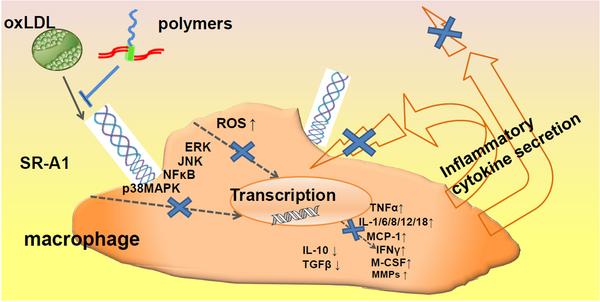Moghe:NanoLipoBlockers
<owwmenu font="arial, helvetica, sans-serif" bold="1" color="black" bgcolor="white" hovercolor="black" bghovercolor="gray" topFontSize="10" fontSize="8" pagewidth="770" image="Moghe ban.jpg" lab="Moghe"> Home= News=News Research= Research,NanoLipoBlockers=NanoLipoBlockers, hESC Biomaterials=hESC Biomaterials, Cell Profiling=Cell Profiling, Rare-Earth ANCs=ANCs Publications=Publications, Highlights=Highlights, All=Publications Talks/Courses=#, Chaired Symposia=Symposia, Presentations=Presentations, Courses=Courses People=People, Moghe Bio=Bio, Students and Post-Docs=People Internal=#, Protocols=Protocols, Notebooks=Notebooks Facilities=Facilities, Confocal=http://www.confocal.rutgers.edu/, BME=http://bme.rutgers.edu/, Biotech=http://biomedical.rutgers.edu/biotech
</owwmenu>
Nanoscale Polymers to Treat Atherosclerosis

Disease Progression
Atherosclerosis is an inflammatory disease that is defined by the buildup of lipid rich plaques in large arteries and is the cause of nearly 50% of all deaths in westernized countries. In the currently accepted model of disease, hyperlipidemia leads to high levels of LDL buildup in the arterial wall, where it is oxidized. This causes chronic injury to the endothelial cell layer and results in the inflammatory response of expression of cytokines and adhesion proteins for monocytes. Monocytes adhere and are transported through the endothelial membrane where they differentiate into macrophages. The macrophages have unregulated uptake of modified LDL (oxLDL) via the scavenger receptor (SR) and become foam cells. The foam cells then express inflammatory cytokines to continue the cycle of inflammation, modification of lipoproteins, and further inflammation. As the lipid laden macrophages accumulate, smooth muscle cells migrate into the lipid layer. Significant buildup leads to a necrotic lipid core surrounded by a fibrous cap. Degradation of the cap and subsequent rupture can lead to a myocardial infarction or a stroke.
Research Approach
The Moghe laboratory, in collaboration with Professor Kathryn Uhrich (Chemistry, Rutgers), has designed nanoscale self-assembled particles whose backbone chemistry and architecture can be systematically varied to exhibit controlled amphiphilicity and anionic groups. The particles are self-assembled from unimers comprised of acylated derivatives of biocompatible mucic acid conjugated with poly(ethylene glycol), where anionic functional groups can be derivatized to either terminus.
Published Results
In a first publication, such nanoparticles were shown to complex with unoxidized LDL but not with oxidized LDL [1]. A coarse grain and molecular dynamics simulation study is ongoing to describe the lipoprotein retentivity of the nanoparticles (Li et al., 2006). Subsequent studies in the Moghe laboratory report that the anionic nanoparticles reduce the kinetics of unoxidized LDL by complexation with LDL but reduce the kinetics of oxidized LDL by binding to scavenger receptors [2]. Recent efforts have identified SRA and CD36 to be the key scavenger receptor targets for the anionic nanoparticles; consequently, blockage of scavenger receptors by the nanoparticles reduced cytokine secretion, foam cell formation, and cholesterol accumulation (Chnari et al., 2006). Certain characteristics of the nanoparticles were found to be requisite to maximal scavenger receptor binding. For example, positioning of anionic groups on hydrophobic termini were found to reduce oxLDL uptake but not if the anionic groups were displayed from hydrophobic termini. Recent studies implicate the size as well as anionic charge density to be important variables that further accentuate the ability of nanoparticles to inhibit oxLDL uptake (Wang et al., 2006). These studies are promising as nanotechnology affords a possible avenue to effectively alter the dynamics of lipoportein matrix retention within the intima. Systematic studies of binding affinities between the nanoparticles and major scavenger receptors are being pursued using surface plasmon resonance.
Future Directions
Further studies are proposed to elucidate how the nanoparticle structure influences the receptor binding, cross-linking, and possible conformational changes leading to receptor internalization. The goals are to identify nanoparticle structures that maximally occupy scavenger receptors with minimal degree of receptor internalization. Animal models are currently being tested to examine the potential for the nanoparticles to reduce inflammation and atherogenesis. The advances in this project have been highlighted recently by news release from the American Chemical Society and Nanobiotechnology News, and industrial partnering is envisioned for successful translation of this project for further development and possible testing for therapeutic potential.
<biblio>
- 2005Chnari pmid=15621265
- 2006Chnari pmid=16768400
- Paper52 pmid=20170758
- Paper47 pmid=19405544
- Paper40 pmid=18215086
- Paper39 pmid=18203436